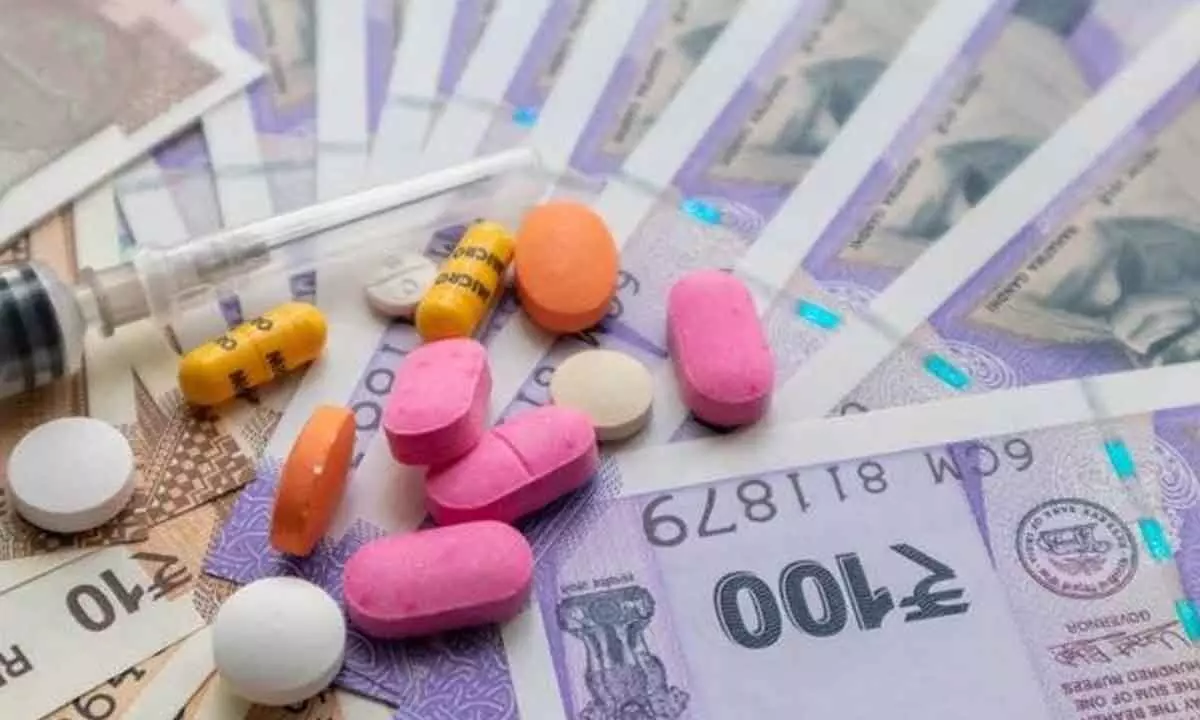Live
- Latur beneficiaries get affordable houses under PMAY, thanks Modi govt
- Rajasthan HC quashes FIR against Shilpa Shetty under SC/ST Act
- Santosh Trophy 2024: Odisha grab big win against Madhya Pradesh
- Innovation programmes to come up at 1,000 campuses in Kerala
- Chelsea's James Reece to miss match against Leicester due to hamstring injury, confirms Maresca
- Aim to design Tirumala into a planned model town'-TTD EO
- Maha records 65.11 per cent polling, highest in three decades
- Have no trust in pre-poll surveys- DKS
- The Rana Daggubati Show at IFFI 2024, Redefining Celebrity Talk Shows
- TN govt to reject Tungsten mining proposal in Madurai district: Forest Minister
Just In
Cutting out-of-pocket costs on healthcare


The Department of Pharmaceuticals (DoP), under the Union Ministry of Chemicals & Fertilisers, is aiming to reduce by half the share of cost of drugs in the out-of-pocket expenditure from the current position by the year 2047 when the country will be celebrating ‘Azadi Ka Amrit Mahotsav’ to commemorate India completing 100 years of Independence.
The Department of Pharmaceuticals (DoP), under the Union Ministry of Chemicals & Fertilisers, is aiming to reduce by half the share of cost of drugs in the out-of-pocket expenditure from the current position by the year 2047 when the country will be celebrating 'Azadi Ka Amrit Mahotsav' to commemorate India completing 100 years of Independence.
The Indian government has already begun work on a blueprint for a future ready India@2047 – a vision plan for the next 25 years to take the country to the next level of growth in all sectors, including pharmaceuticals and medical devices. The central government has already drafted a Roadmap for pharma and medical devices sectors for India@2047, and one of the thrust areas is to half the cost of drugs in out-of-pocket expenditure.
The DoP is currently in discussion with the pharmaceutical industry for finalising a draft of the roadmap for pharma and medical device sectors for the year 2047. According to the Union Health Ministry's National Health Accounts estimates for the year 2017-18 published late last year, household's out of pocket expenditure on health is Rs 2,76,532 crore (48.8 per cent of the total health expenditure, 1.6 per cent of GDP, Rs 2,097 per capita), and private health insurance expenditure is Rs 33,048 crore (5.8 per cent of the total health expenditure). The out of pocket expenditure on health as a percent of total health expenditure has come down from 64.2 per cent in 2013-14 and on a longer term, from Rs 69.4 per cent in 2004-05.
It is commendable that the Roadmap has identified several features which are necessary to take the industry to the next level to reduce by half the share of cost of drugs in the out-of-pocket expenditure from the current position by the year 2047. The Roadmap, which is an exercise as part of the government's plans to prepare 'Vision 2047' for various sectors including pharma and medical devices, aims to establish a centre for precision medicines and moving towards green manufacturing practices in pharma and medical device sector through research and education.
In the medium term, by the year 2037, the roadmap expects the brain drain to be reversed to brain gain and an innovation pipeline with five to seven new molecular entities and 10-12 launches per year. It is expected to expand the existing National Institutes of Pharmaceutical Education and Research (NIPERs) and set up new ones, expanding National Institutes of Medical Devices Education and Research (NIMERs) for medical devices industry to 10 institutes from the three aimed in short term by 2027.
The long-term vision for the year 2047 include enhancing NIPERs as world-class and renowned institutes in pharma, medical devices and healthcare sectors and driving pharma to become a value-based sector through innovation. It also aims at generating entrepreneurs through expansion of Pradhan Mantri Bhartiya Jan Aushadhi Pariyojana, strengthening Intellectual Property Rights landscape for pharma and medical devices, having leadership in three of the 10 top technologies in medical technologies, developing integrated digital delivery of products and services for patient monitoring, improving quality of life through personalised medicines and collaborative research with producing at least 1,000 Ph.D in pharma annually, in the medium term.
By the time, it is also expected to have integrated regulators for pricing, quality and service delivery and a robust and resilient pricing policy for healthcare security. It also aims to move towards 50 per cent of all prescriptions to generics. In the near term, by the year 2027, it is expecting to set up three NIMERs for medical devices, establish Centre of Excellence on medical devices, nutraceuticals, precision medicines, biosimilars, cell and gene therapy, phyto-pharma, and marine pharmaceuticals. It would also look at Artificial Intelligence equipped diagnostic and monitoring systems including QR code technology for public awareness and information.
A digital database of all research related to pharma, medical devices and biotech, research consortium of pharma, biopharma and medical devices with dedicated fund for innovation and expanding and strengthening the Jan Aushadhi scheme to achieve coverage by one Kendra per one lakh population are some of the other goals set for the year 2027. Of course, there is huge task to identify the future trends and take the technological advances and the kind of demography and disease profile, and finally the kind of therapeutic platforms that the industry will be working on over the next 25 years while preparing the roadmap for 2047.
(The author is a freelance journalist with varied experience in different fields)

© 2024 Hyderabad Media House Limited/The Hans India. All rights reserved. Powered by hocalwire.com






